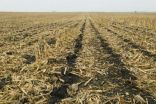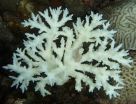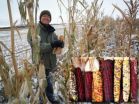(Press-News.org) URBANA – Increased levels of greenhouse gases, particularly carbon dioxide (CO2), have been associated with the burning of fossil fuels, deforestation, cultivation of grasslands, drainage of the land, and land use changes. Concerns about long-term shifts in climate patterns have led scientists to measure soil organic carbon (SOC) in agricultural landscapes and to develop methods to evaluate how changes in tillage practices affect atmospheric carbon sequestration. University of Illinois professor of soil science Kenneth Olson has used data collected over a 20-year period at Dixon Springs, Ill., to develop a new protocol for more accurately measuring the carbon removed from the atmosphere and subsequently sequestered in the soil as SOC.
"Many experiments comparing no-till to conventional tillage on similar soils have shown no-till to have higher levels of soil organic carbon," Olson said. "So we know in general that no-till is often better than conventional tillage at building or retaining more of the organic matter in the soil, which is important to crop productivity. However, this does not mean that no-till is necessarily sequestering atmospheric carbon. It is often just losing carbon at a lower rate than conventional tillage." This unexpected discovery was the result of Olson's use of a pre-treatment SOC measurement method that compares change in soil organic carbon over time on the same plots using the same tillage methods. "This protocol does not assume that soil carbon pools are at steady state (remain the same over time), but measures SOC at the beginning of an experiment, at intervals during, and at the end of the experiment," Olson said.
"Comparison studies with one treatment as the baseline (usually conventional tillage) or control and other tillage such as no-till as the experimental treatment should not be used to determine SOC sequestration if soil samples are only collected and tested once during or at the end of the study," Olson said. The comparison method assumes the conventional tillage baseline to be at a steady state and having the same amount of SOC at the beginning and at the end of the long-term study, and this may not be true. No-till as the experiment treatment needs to be compared to itself on the same soils over time to determine if SOC sequestration has really occurred.
Olson compared two decades of data from previously eroded Grantsburg soils on 6 percent slopes to a 30-inch depth with low SOC content in an attempt to quantify the amount and rates of SOC sequestration, storage, retention, or loss as a result of a conversion from conventional tillage to a no-till system. Olson used both the comparison and the pre-treatment SOC measurement methods on the same plot area. His analysis revealed conventional tillage and no-till plot areas had less carbon (C) at the end of the study than at the beginning using the pre-treatment SOC method. According to the comparison method, no-till sequestered 4.1 tons of C per acre for a 17 percent gain during the 20 years of the study. However, the pre-treatment SOC method showed that the no-till plots actually lost 3.1 tons of C per acre, a 13 percent loss in 20 years. Thus, no SOC sequestration had actually occurred during the Dixon Springs study.
There were three major reasons why the comparison study approach was the wrong method for measuring C sequestration on the Dixon Springs plot area. First, the conventional tillage plots were not at steady state and actually lost 30 percent of the C in 20 years due to erosion and SOC-rich sediment being transported off the plots. Second, when the no-till and conventional tillage plots were sampled only once, it was not possible to determine the rate of change over time. Last, the effect of tillage equipment breaking down the soil aggregates increased the carbon available to microbial decomposition and the release of C to the atmosphere as CO₂.
"Field experiments must be designed to more carefully measure, monitor, and assess internal and external inputs," Olson said. "The amount of SOC loss from soil storage during the time of the experiment needs to be subtracted from SOC gains to determine the change in net SOC storage. Further, soil laboratory and field methods for quantifying SOC concentration must be refined to reduce under- and over-estimation bias."
Olson also recommends that the definition of SOC sequestration include a reference to the land unit. "Soil organic carbon sequestration is currently defined as the process of transferring CO₂ from the atmosphere into the soil through plants, plant residues, and other organic solids that are stored or retained as part of the soil organic matter (humus). The retention time of sequestered carbon in the soil (terrestrial pool) can range from short-term (not immediately released back to the atmosphere) to long-term (millennia) storage," Olson said. The SOC sequestration process should increase net SOC storage during and at the end of a study to above the previous pre-treatment baseline levels and result in a net reduction in the atmospheric CO₂ levels. I believe that the phrase 'of a land unit' needs to be added to the definition to add clarity and to exclude the loading or adding of organic C derived naturally or artificially from external sources," Olson suggested.
Olson concluded by saying that carbon not directly from the atmosphere and from outside the land unit should not be counted as sequestered SOC. The definition of SOC sequestration as defined with borders would mean any C already in storage and transported or redistributed to the plot area or field would have to be accounted for and does not qualify as sequestered SOC.
"Any manure from outside the plot area or SOC-rich sediments transported and deposited from adjacent upland are just redistributed or transported C and not really sequestered SOC," Olson said. "That C was already in storage and may in fact be released back to the atmosphere if applied to the plot. For example, decomposing manure loaded on a land unit increases the return of CO₂ to the atmosphere and does not result in a depletion of atmospheric CO₂, which is the real goal. Because we often lack the ability to directly measure the total change in the atmospheric CO₂ as a result of C loading on a plot or field, we indirectly estimate it by measuring the change in amount of SOC being stored in the land unit.
"These proposed protocols are necessary to move the science forward and to attempt to address future predicted climate trends," Olson said. "The amount of SOC sequestered as a result of alternative agricultural systems such as no-till and its effects on net SOC storage changes in the soil over time and the SOC released to the water and atmospheric pools need to be measured or calculated."
Olson said that any future Cap and Trade program will require SOC sequestration protocols to be established. The method of measurement is critical if SOC sequestration is to be verified. "If landowners are to truly sequester SOC, they must be able to prove that net carbon gains have occurred over time in their fields and that the increased SOC remains permanently stored in their soil," Olson said.
INFORMATION:
"Soil organic carbon sequestration, storage, retention and loss in U.S. croplands: Issues paper for protocol development" is published online and will appear in the March 2013 issue of Geoderma.
New protocol recommendations for measuring soil organic carbon sequestration
2013-02-01
ELSE PRESS RELEASES FROM THIS DATE:
Gap geometry grasped
2013-02-01
Theoretical physicist Moumita Maiti and colleagues at the Jawaharlal Nehru Centre for Advanced Scientific Research in Bangalore, India, have now implemented an algorithm for analysing void space in sphere packing, where the spheres need not all be the same size. This method, about to be published in EPJ E, could be applied to analyse the geometry of liquids present between multi-sized spheres that are akin to a model for porous material. This provides a tool for studying the flow of such fluids through porous material. More importantly, it can also be used to study the ...
How do corals survive in the hottest reefs on the planet?
2013-02-01
Coral reefs are predicted to decline under the pressure of global warming. However, a number of coral species can survive at seawater temperatures even higher than predicted for the tropics during the next century. How they survive, while most species cannot, is being investigated by researchers at the National Oceanography Centre, Southampton (NOCS) and New York University Abu Dhabi (NYUAD).
We tend to associate coral reefs with tropical seas of around 28 degrees, where even slight warming can have devastating effects on corals. But in the Arabian/Persian Gulf, corals ...
European investments in advanced computing systems deliver results
2013-02-01
January 31, 2013 - At the HiPEAC 2013 conference in Berlin, KALRAY demonstrated MPPA256, the world's first supercomputer-on-a-chip, consisting of 256 computing cores. This innovative processor combines the ultimate in several processor types and will enable a whole new class of embedded and industrial applications in the fields of image processing, signal processing, control, communications and data security. The MPPA256 is completely designed in Europe and is only one of the success stories resulting from the 170 million Euro investment in carefully selected European funded ...
Routes towards defect-free graphene
2013-02-01
A new way of growing graphene without the defects that weaken it and prevent electrons from flowing freely within it could open the way to large-scale manufacturing of graphene-based devices with applications in fields such as electronics, energy, and healthcare.
A team led by Oxford University scientists has overcome a key problem of growing graphene – a one atom-thick layer of carbon – when using an established technique called chemical vapour deposition, that the tiny flakes of graphene form with random orientations, leaving defects or 'seams' between flakes that ...
Study: Infection preventionists know safe care
2013-02-01
Washington, DC, February 1, 2013 – There is general agreement among hospital infection preventionists (IPs) with respect to which practices have weak or strong evidence supporting their use to prevent healthcare-associated infection, according to a new study published in the February issue of the American Journal of Infection Control, the official publication of the Association for Professionals in Infection Control and Epidemiology (APIC).
Furthermore, IPs with certification in infection prevention and control (CIC®) are two to three times more likely to perceive the ...
New study sheds light on link between dairy intake and bone health
2013-02-01
Boston - A study by researchers at the Institute for Aging Research (IFAR) at Hebrew SeniorLife, an affiliate of Harvard Medical School (HMS), has found that dairy intake —specifically milk and yogurt —is associated with higher bone mineral density (BMD) in the hip, but not the spine. Cream, on the other hand, may be associated with lower BMD overall. Published today in the journal Archives of Osteoporosis, these findings suggest that not all dairy products are equally beneficial in promoting bone strength.
"Dairy foods provide several important nutrients that are beneficial ...
If you are impulsive, take modafinil and count to 10
2013-02-01
Philadelphia, PA, February 1, 2013 – Poor impulse control contributes to one's inability to control the consumption of rewarding substances, like food, alcohol, and other drugs. This can lead to the development of addiction. FDA-approved medications for alcoholism, like naltrexone (Revia) and disulfiram (Antabuse), are thought to reduce alcohol consumption by curbing cravings and creating unpleasant reactions to alcohol, effects which reduce the desire to drink alcohol.
New medications, however, might target the uncontrollable urges to consume drugs of abuse. The idea ...
Programming cells: The importance of the envelope
2013-02-01
In a project that began with the retinal cells of nocturnal animals and has led to fundamental insights into the organization of genomic DNA, researchers from Ludwig-Maximilians-Universitaet (LMU) in Munich show how the nuclear envelope affects nuclear architecture - and gene regulation.
The double-stranded DNA molecules that make up the genetic material are wrapped around protein complexes to form compacted "chromatin". The active portion of the genome is less densely packed, and thus more easily accessible, than the inactive fraction, and is referred to as euchromatin. ...
Can plants be altruistic? You bet, says new CU-Boulder-led study
2013-02-01
We've all heard examples of animal altruism: Dogs caring for orphaned kittens, chimps sharing food or dolphins nudging injured mates to the surface. Now, a study led by the University of Colorado Boulder suggests some plants are altruistic too.
The researchers looked at corn, in which each fertilized seed contained two "siblings" -- an embryo and a corresponding bit of tissue known as endosperm that feeds the embryo as the seed grows, said CU-Boulder Professor Pamela Diggle. They compared the growth and behavior of the embryos and endosperm in seeds sharing the same mother ...
Disparities exist in kidney transplant timing
2013-02-01
Highlights
African Americans and individuals without private health insurance are less likely to receive a kidney transplant before needing dialysis.
Geographic region is not a major factor in determining whether a patient receives a kidney transplant before starting dialysis.
Nearly 90,000 people in the U.S. are waiting for a kidney transplant, and many will die before a suitable organ becomes available.
Washington, DC (January 31, 2013) — African-Americans and individuals without private health insurance are less likely than others to receive a kidney transplant ...


